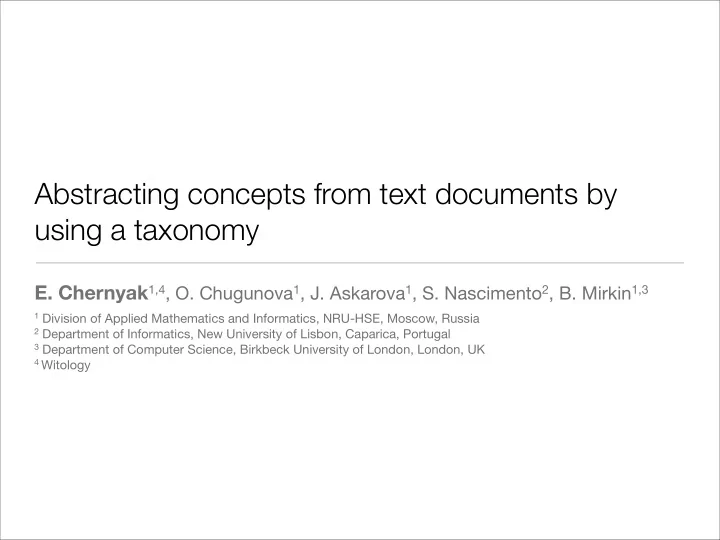

Abstracting concepts from text documents by using a taxonomy E. Chernyak 1,4 , O. Chugunova 1 , J. Askarova 1 , S. Nascimento 2 , B. Mirkin 1,3 1 Division of Applied Mathematics and Informatics, NRU-HSE, Moscow, Russia 2 Department of Informatics, New University of Lisbon, Caparica, Portugal 3 Department of Computer Science, Birkbeck University of London, London, UK 4 Witology
Contents 1. Statement of the problem 2. Method 3. Examples of application 4. Future work
Statement of the problem •Interpretation of a text corpus over a taxonomy (the main part of an ontology) Article: Two variable logic on data trees and XML reasoning, Journal of the ACM, 2003 Motivated by reasoning tasks for XML languages , the satisfiability problem of logics on data trees is investigated. The nodes of a data tree have a label from a finite set and a data value from a possibly infinite set. It is shown that satisfiability for two-variable first-order logic is decidable if the tree structure can be accessed only through the child and the next sibling predicates and the access to data values is restricted to equality tests. From this main result, decidability of satisfiability and containment for a data-aware fragment of XPath and of the implication problem for unary key and inclusion constraints is concluded.Motivated by reasoning tasks for XML languages , the satisfiability problem of logics on data trees is investigated. The nodes of a data tree have a label from a finite set and a data value from a possibly infinite set. It is shown that satisfiability for two-variable first-order logic is decidable if the tree structure can be accessed only through the child and the next sibling predicates and the access to data values is restricted to equality tests. From this main result, decidability of satisfiability and containment for a data- aware fragment of XPath and of the implication problem for unary key and inclusion constraints is concluded.
Input Collection of the ACM Journal The ACM Computing abstracts Classification System (1998) ... ... ...
Input Collection of the ACM Journal The ACM Computing abstracts Classification System (1998) ... Primary Classification: F.1.1 Additional Classification: F.1.3, H.2.4 ... ... Primary Classification: F.4.1 Additional Classification: F.4.3, H.2.1, H.2.3, I.7.2
Output Head subjects and related events (gap, offshoot) Profile of a text collection ofile of a text collection Desired Interpretation Code Membership ACM-CCS Topic Head subjects: value 0.597 Complexity Measures and Classes H.2 DATABASE MANAGEMENT F .1.3 0.475 Languages H.2.3 0.4009 Tradeoffs between Complexity Measures F. Theory of Computation F .2.3 0.3705 Logical Design H.2.1 0.322 Models of Computation F .1.1 0.2973 Systems H.2.4 0.24 Metrics D.2.8 0.2193 Database Applications H.2.8 0.211 SOCIAL AND BEHAVIORAL SCIENCES J.4 0.0178 Algorithms I.1.2 ...
Method 1.Building a profile of the collection A. Annotated suffix tree for abstracts and keywords (Pampapathi, Mirkin, Levene, 2006) B. Scoring ACM-CCS leaves including references between them C. Clustering the profiles (if needed) 2.Lifting the profile in the taxonomy tree A. Specifying head subject, gap and offshoot penalty weights B. Parsimonious lifting (Mirkin, Nascimento, Fenner, Pereira, 2010)
Annotated Suffix Tree (AST) for “xabxac” • is used to compute and store the frequencies of all substrings of the string
Lifting •Represent the thematic clusters in ACM-CCS by higher, more general, nodes depending on the inconsistencies ( Lift )
Two applications •The Journal of ACM abstracts and the ACM-CCS •Course syllabuses of Mathematics and Informatics disciplines and an in-house taxonomy of Mathematics and Informatics built using Supreme Attestation Committee of Russia documentation (in Russian)
A “good” AST–profile Article: Two variable logic on data tr Article: Two variable logic on data tr wo variable logic on data trees and XML r ees and XML reasoning, Jour easoning, Journal of the ACM, 2003 nal of the ACM, 2003 AST found pr AST found profile ACM-CCS index terms (manual annotation) ACM-CCS index terms (manual annotation) ACM-CCS index terms (manual annotation) ID TE ACM–CCS topic ID # ACM–CCS topic H.2.3 0.4541 Languages H.2.3 0 Languages I.1.3 0.4489 Languages and Systems F.4.3 2 Formal Languages F.4.3 0.3918 Formal Languages H.2.1 12 Logical Design D.4.5 0.3049 Reliability F.4.1 27 Mathematical Logic I.6.2 0.2578 Simulation Languages I.7.2 52 Document Preparation
A “poor” AST–profile Article: Lower bounds for pr Article: Lower bounds for pr Article: Lower bounds for processing data with few random accesses to exter ocessing data with few random accesses to exter ocessing data with few random accesses to exter ocessing data with few random accesses to external memory. Journal of the ACM, 2003 nal of the ACM, 2003 nal of the ACM, 2003 AST found profile AST found pr ACM-CCS index terms (manual annotation) ACM-CCS index terms (manual annotation) ACM-CCS index terms (manual annotation) ID TE ACM–CCS topic ID # ACM–CCS topic H.2.8 0.4330 Database Applications F.1.3 160 Complexity Measures and Classes H.2.5 0.2904 Heterogeneous Databases H.2.4 165 Systems C.5.1 0.2630 Large and Medium F.1.1 219 Models of Computation (``Mainframe'') Computers J.1 0.2115 ADMINISTRATIVE DATA PROCESSING I.2.7 0.1870 Natural Language Processing
Conclusion • Interpretation by producing profiles and lifting them in the taxonomy • Issues A. AST scoring – slow and noised B. The taxonomies are not quite relevant C. Penalty weights? (Future work: change the parsinomy criterion for that of the maximum likelihood) D. Assessment of the results
Recommend
More recommend